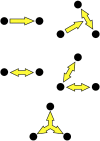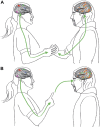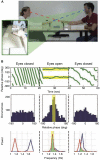Socializing Sensorimotor Contingencies
- PMID: 34602990
- PMCID: PMC8480310
- DOI: 10.3389/fnhum.2021.624610
Socializing Sensorimotor Contingencies
Abstract
The aim of this review is to highlight the idea of grounding social cognition in sensorimotor interactions shared across agents. We discuss an action-oriented account that emerges from a broader interpretation of the concept of sensorimotor contingencies. We suggest that dynamic informational and sensorimotor coupling across agents can mediate the deployment of action-effect contingencies in social contexts. We propose this concept of socializing sensorimotor contingencies (socSMCs) as a shared framework of analysis for processes within and across brains and bodies, and their physical and social environments. In doing so, we integrate insights from different fields, including neuroscience, psychology, and research on human-robot interaction. We review studies on dynamic embodied interaction and highlight empirical findings that suggest an important role of sensorimotor and informational entrainment in social contexts. Furthermore, we discuss links to closely related concepts, such as enactivism, models of coordination dynamics and others, and clarify differences to approaches that focus on mentalizing and high-level cognitive representations. Moreover, we consider conceptual implications of rethinking cognition as social sensorimotor coupling. The insight that social cognitive phenomena like joint attention, mutual trust or empathy rely heavily on the informational and sensorimotor coupling between agents may provide novel remedies for people with disturbed social cognition and for situations of disturbed social interaction. Furthermore, our proposal has potential applications in the field of human-robot interaction where socSMCs principles might lead to more natural and intuitive interfaces for human users.
Keywords: autism spectrum disorder; coordination dynamics; coupling; human–robot interaction; joint action; prediction; sensorimotor contingencies.
Copyright © 2021 Lübbert, Göschl, Krause, Schneider, Maye and Engel.
Conflict of interest statement
The authors declare that the research was conducted in the absence of any commercial or financial relationships that could be construed as a potential conflict of interest.
Figures




References
-
- Ansermin E., Mostafaoui G., Beaussé N., Gaussier P. (2016). “Learning to synchronously imitate gestures using entrainment effect,” in From Animals to Animats 14. SAB 2016, eds Tuci E., Giagkos A., Wilson M., Hallam J. (Cham: Springer; ), 219–231.
-
- Ansermin E., Mostafaoui G., Sargentini X., Gaussier P. (2017). “Unintentional entrainment effect in a context of human robot interaction: an experimental study,” in Proceedings of the 2017 26th IEEE International Symposium on Robot and Human Interactive Communication (RO-MAN). (Piscataway, NJ: IEEE; ), 1108–1114.
-
- Asperger H. (1944). Die, in Autistischen Psychopathen“ im Kindesalter. Arch. Psychiatr. Nervenkrankh. 117 76–136. 10.1007/bf01837709 - DOI
LinkOut - more resources
Full Text Sources

